Distal biceps repair
Make an AppointmentThe distal biceps is important for flexing (or bending) your elbow and also for rotating your forearm outwards (supination).
Biceps Tendon (Anatomy)
The biceps tendon starts in the shoulder and attaches down around the elbow joint. In the shoulder it has 2 different origins, one from inside the shoulder joint and the other from a bone outside the joint. These 2 tendons then join and form the main muscle mass in the front of your arm which you can easily palpate. This muscle mass then becomes one single thick tendon (the distal biceps tendon) and attaches to the radial tuberosity which is a bone found around your elbow joint.
When you contract or flex your elbow you can easily palpate this tendon. The distal biceps is important for flexing (or bending) your elbow and also for rotating your forearm outwards (supination). Therefore when this tendon ruptures you lose strength of flexion and supination.
How do patients present?
The overwhelming majority of patients that rupture their biceps tendons are male. The injury usually occurs after a sudden lift or when your elbow is loaded in an unusual way (can be forced into extension). The patients are generally aged between 25 and 65 years of age and often the dominant arm is affected. When the tear occurs you often hear or feel a snap and a tearing sensation. A lump can often be palpated in the lower arm as the tendon retracts around your elbow.
Tenderness is then felt in your elbow crease and bruising can occur within 24 hours. The pain slowly settles but you are generally left with weakness of elbow flexion and weakness of rotating your forearm outwards (the motion used for a screwdriver). When the tendon remains ruptured these actions remain permanently weak.
How is the diagnosis made for Distal Biceps Ruptures?
The diagnosis can generally be made from the patient’s history and physical examination. As mentioned above, bruising is characteristic around the elbow joint, one also finds patients have tenderness around the normal course of the biceps tendon. The biceps tendon when completely ruptured is also very difficult to palpate or feel along its normal course as it often retracts up the arm. If one is unsure of the clinical diagnosis then a more definitive diagnosis can be made with imaging such as an ultrasound or the gold standard test of a MRI scan. Once the diagnosis is confirmed then treatment options can be considered.
How are Distal Biceps Tendon Ruptures Treated?
For the majority of patients a distal biceps rupture causes significant weakness around their elbow. For these reasons surgery is generally recommended so as to restore function around the elbow. Conservative or non-operative treatment is generally recommended for those that have very low demands on their elbow with the understanding that there will always be an element of weakness.
How long after I rupture my tendon have I got to have it repaired?
The sooner you are seen after you rupture your tendon the easier it is to repair. Beyond 4 weeks after the injury it is very difficult to repair and the results are not as rewarding. The tendon after the rupture starts to retract up the arm and gets to a stage after 4 to 6 weeks where it cannot be brought down to its anatomical position of attachment.

Photo showing a distal biceps rupture with swelling and the muscle belly sitting higher than normal.
The Operation for Distal Biceps Ruptures
The distal biceps tendon ruptures off the bone called the radius at its proximal end near the elbow joint.
The part of the radius it arises from is called the radial tuberosity. This part of the radius rotates around the other bone in the elbow called the ulna allowing the motion of rotation. The biceps tendon has to be surgically repaired to this anatomical part of the radius to allow full function to occur. In my practice I prefer to use 1 small incision to allow the most anatomical repair therefore restoring near to normal function.
The incision is made in your elbow crease at the front of your arm. This incision is about 3 cm long and through this exposure we find your ruptured tendon.
Sutures are then woven up and down the tendon and these are then used to reattach the tendon to the bone (radial tuberosity). The biceps is then pulled through a drill hole in the radius bone with an adjustable button and is secured with a screw in its anatomical position.
Once the tendon is reattached we put your elbow through a normal range of motion to check all is secure and functioning normally.
It is now up to the tendon to heal back to the bone and for your elbow to slowly regain function.
What happens after surgery for Distal Biceps Ruptures?
The surgery generally takes about an hour. Your elbow is placed in a bandage and also a sling to protect the repair. No plaster is necessary. This operation can be performed as a day case procedure or sometimes as an overnight procedure. I get you to start moving your elbow the next day to prevent stiffness. The movement you start doing is called passive which means you get your other hand to hold your affected wrist as you move your arm to prevent a load being placed through the repair. I start with 2 exercises which are passive flexion and passive supination during the first 6 weeks as seen in the pictures.
Unfortunately for the majority of the remaining 6 weeks you have to rest your arm in the sling to allow the tendon to heal.
During these 6 weeks you can take your arm out of the sling when sitting down or resting. One can generally do simple tasks such as using keyboards, eating and drinking. No weight heavier than a full coffee cup should be put through your elbow during this time of healing.
After 6 weeks a physiotherapy programme is started so you regain strength and function in your arm. It takes 4 to 6 months for your elbow to recover and feel reasonably normal. Heavy loads should not be put through your elbow in this time.
What is the success rate of surgery?
In my hands most patients are very happy with the operation and are very glad they have had it performed. The majority of patients recover their full range of motion and strength after a 4 to 6 month recovery period. Most patients can return to their preinjury functional level after this period of time.
What complications can occur with this operation?
The complications after a distal biceps repair are very small but possible. Firstly, if the tendon is of poor quality it maybe irreparable. Some of the other complications include nerve damage as the tendon travels close to major nerves in your arm, blood vessel injury, and re-rupture of the tendon. The other major complication that can occur is where your tendon repair heals rapidly causing extra bone to develop and subsequent loss of rotation of your forearm. If this occurs then a second operation is necessary to remove the bone so as to allow the rotation to recur.
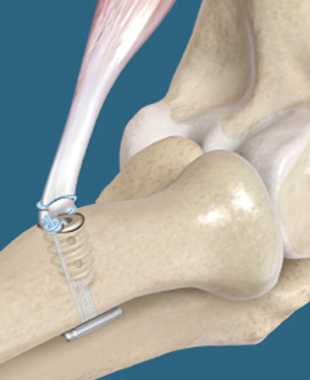
Image showing biceps tendon fixed to the radius with a drilled socket, a button to tension the repair and a screw for a more secure hold
Passive Flexion
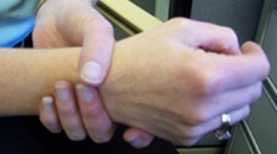
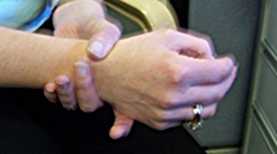
Passive Supination
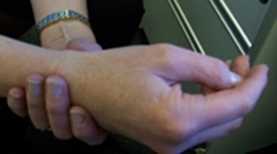
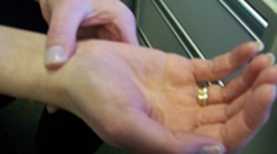
Frequently Asked Questions
Q: How long am I in hospital for?
A: Often just one day but maybe overnight depending on how you feel after your general anaesthetic.
Q: How long do I need to wear a sling for?
A: 6 weeks
Q: When can I drive?
A: You cannot drive whilst wearing a sling so not for 6 weeks.
Q: When can I return to work?
A: It really depends on the type of work that you do. If your work is office based and deskwork you could expect to be back at work within a week or 2 so long as you had some way of getting there. Any work involving heavy lifting would need to be avoided until 4-6 months after your surgery.
Patient info
Mr. Satyen Gohil is a no gap provider for all health funds (provided your health fund covers the procedure), meaning that for the surgery, there no extra costs charged to the patient for the surgery or anaesthetic above that which is covered by the health funds.
Initial consultation cost is $200 Follow up appointments are $100 There are no further costs for post-operative visits for the first 6 weeks, after which time the cost of each visit is $100. Workers compensation and MVIT consultation fees will be sent direct to the insurer. However, if the claim number is not provided you will be responsible for settling the account on the day.
Blood tests
There is an out of pocket charge for blood tests.
Anaesthetist
Your anaesthetist will be Dr. Harper, Dr.Crossley, Dr. White or Dr. Thompson, who will contact you by telephone before the day of surgery to explain about the anaesthetic. They will see you on the day of surgery in the hospital.
Radiology
X-rays as an inpatient are covered, but outpatient X-rays and CTs within the hospital have an out of pocket cost.
MRI costs vary considerably depending on where they are done. Please ask for more details.
www.skg.com.au
Cardiology
For ECG (heart tracings) I use WA cardiology as appointments are not needed. There is a charge above the Medicare rebate.
www.wacardiology.com.au
Medical reports and insurance forms
Are charged at a rate representing the time taken to complete the forms.
Full payment at the appointment time is appreciated. Cash or credit cards are acceptable means of payment. For bank and personal cheque please make prior arrangements with the reception.
Useful links
Medicare Australia
http://www.medicareaustralia.gov.au/
St John of God Murdoch Hospital
http://www.sjog.org.au/hospitals/murdoch.aspx
Department of Veteran Affairs
http://www.dva.gov.au/Pages/home.aspx
Make an appointment with Mr Satyen Gohil.
Please get in touch with us by completing the form here or alternatively you can contact us by fax or phone at the numbers below. We will endeavour to get back to you as soon as possible.
